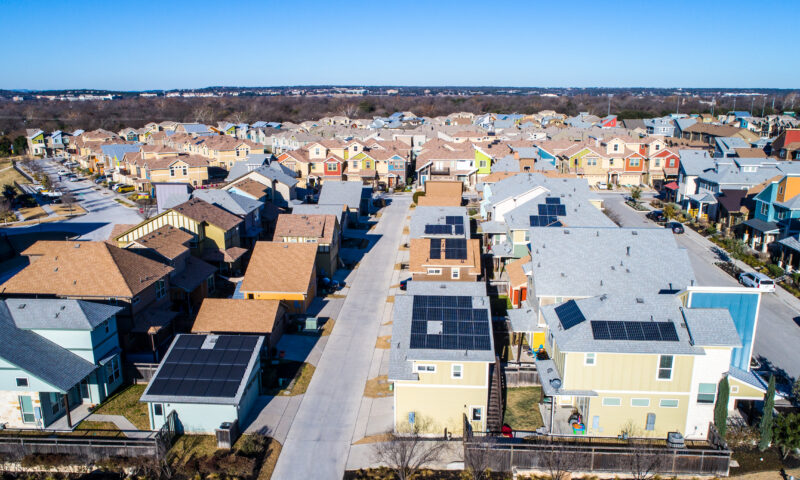This story was produced by Puente News Collaborative, a bilingual nonprofit newsroom, convener and funder dedicated to high-quality, fact-based news and information from the U.S.-Mexico border.
At Hector’s Mariscos restaurant in the heavily Latino and immigrant city of Santa Ana, sales of Mexican seafood have slid. Seven tables would normally be full, but diners sit at only two this Tuesday afternoon.
“I haven’t seen it like this since COVID,” manager Lorena Marin said in Spanish as cumbia music played on loudspeakers. A U.S. citizen, Marin even texted customers she was friendly with, encouraging them to come in.
“No, I’m staying home,” a customer texted back. “It’s really screwed up out there with all of those immigration agents.”
Increasing arrests in California by U.S. Immigration and Customs Enforcement agents have begun to gut-punch the economy and wallets of immigrant families and beyond. In some cases, immigrants with legal status and even U.S. citizens have been swept into President Donald Trump’s dragnet.
The 2004 fantasy film A Day Without a Mexican — chronicling what would happen to California if Mexican immigrants disappeared — is fast becoming real life. The implications are stark for many, both economically and personally.
“We are now seeing a very significant shift toward enforcement at labor sites where people are working,’ said Andrew Selee, president of the non-partisan Migration Policy Institute. “Not a focus on people with criminal records, but a focus on people who are deeply integrated in the American economy.”
In California, immigrant workers comprise larger shares of certain industries than they do for the nation overall. Here, the foreign-born make up 62% of agriculture labor and 42% of construction workers, according to the American Immigration Council. Some 85% of sewing machine operators in garment factories are foreign-born. And 40% of entrepreneurs are foreign-born.
Nationally, about a fourth of workers in agriculture and construction are foreign-born, according to the American Immigration Council. More than half of drywall hangers, plasterers and stucco masons are foreign-born. And in science-technology-engineering-and-math, so-called STEM fields, nearly a quarter of workers are foreign-born, said the American Immigration Council.
The current enforcement trend, Selee said, will “lead to a strategy that will have big economic implications if they continue to go after people who are active in the labor force rather than those who have criminal records.”
In both California and across an aging nation, about half of the foreign-born are naturalized U.S. citizens — a crucial defense in immigration raids and arrests.
Selee said the current strategy was launched when “the Trump administration realized they weren’t getting large numbers by following traditional approaches to pursuing people who are priority targets for deportation.”
Now, the threat and chilling effect from immigration raids can be felt in disparate communities from Dallas to El Paso to rural Wisconsin — among migrants and in some cases, the employers who hire them.
In the tiny town of Waumandee in Wisconsin, dairy farmer John Rosenow said he can’t find U.S. citizens who can withstand the rigors of dairy work.
“Fact of the matter is if you want to eat or drink milk you are going to need immigrant workers,” he said.
“Yes, we want to get rid of the people who are bad actors,” Rosenow said. “But the people I know, people who are working in the dairy farms, are just hard-working people, getting things done, doing jobs Americans don’t want to do.”
In California’s San Joaquin Valley, rancher and melon-grower Joe Del Bosque has heard reports of U.S. agents chasing workers in the strawberry fields of south of his operation.
The San Joaquin Valley, known as the food basket of the world, is heavily dependent upon foreign born workers, especially at harvest time, Del Bosque said. He currently has 100 people who work for him and those numbers will double as the harvest picks up in the coming weeks.
“They’re going to disrupt the harvest and food chain. This will hurt the American consumer,” Del Bosque said. “These people are hard workers. They come to work, especially if they have families here or in Mexico.”
In a surprise on Thursday, Trump said an executive order is “potentially coming, allowing some illegal immigrants to stay in the country so farmers don’t run out of workers.”
Raids or the threat of them, are also taking an emotional toll on families and generating protests in Los Angeles, Chicago, Seattle, Spokane, New York, San Antonio, Dallas and elsewhere.
In El Paso, protesters flipped the White House script that undocumented immigrants were “criminals.” They waved mostly U.S. flags and shouted “No justice, no peace. Shame on ICE.”
Among the protesters was Alejandra, a U.S. citizen and a junior at the University of Texas at El Paso. She asked for partial anonymity for fear of reprisal against her mixed-status family.
She said she took to this border city’s streets to honor the sacrifice of grandparents who migrated from Ciudad Juarez. “All it takes is for you to look at who took that first step to bring you the life you have currently,” Alejandra said.
In the Dallas area, a Guatemalan said he’d been absent from construction sites for days.
“There’s too much fear, too much to risk,” said Gustavo, 34, requesting his surname be withheld because he is undocumented. “I fear tomorrow, tonight. I may be deported and who loses? My family back in Guatemala.”
Tough immigration enforcement has been the top-polling issue for Trump. But favor may be slipping. A poll released last week by Quinnipiac University showed Trump had a 43% approval rating on immigration and a 54% disapproval rating. That poll was conducted between June 5-9 — after several days of protests.
Meantime, back in Santa Ana, a city of about 316,000 in Southern California, shop owner Alexa Vargas said foot traffic has slowed around her store, Vibes Boutique, with sales plummeting about 30% in recent days.
On a recent day, the shop’s jeans and glitzy tee-shirts remain un-browsed. Metered parking spots on the usually busy street sat empty. A fruit and snow cone vendor whom Vargas usually frequents had been missing for days.
“It shouldn’t be this dead right now,” Vargas, 26, said on a Tuesday afternoon. “People are too scared to go out. Even if you’re a citizen but you look a certain way. Some people don’t want to risk it.”
Reyna, a restaurant cook, told her boss she didn’t feel safe going to work after she heard about the immigration detentions at Home Depot stores in the city.
The 40-year-old, who is in the U.S. without legal status, said she fears becoming an ICE target. Current immigration laws and policies don’t provide a way to obtain legal status even though she’s been living in the U.S. for more than 20 years.
“I need to work but, honestly, I’m scared to death to leave my house,”
For now her life is on hold, Reyna said.
She canceled a party for her son’s high school graduation. She no longer drives her younger children to summer school. She even stopped attending behavioral therapy sessions for her 7-year-old autistic son.
Reyna said she can’t sleep. She suffers headaches every day.
Early Tuesday, she said, immigration agents in an unmarked vehicle swept up her husband’s 20-year-old nephew, who is a Mexican national without legal status. The scene unreeled across from her home.
Her autistic son, a U.S.-born citizen, has begged her to allow him to play on the front yard swing set.
“No, honey. We can’t go outside,” Reyna told him.
“Why?” he asked.
“The police are taking people away,” she explained. “They are taking away people who were not born here.”


 Pain & ProfitNovember 3, 2025
Pain & ProfitNovember 3, 2025
 Column - State of InequalityNovember 6, 2025
Column - State of InequalityNovember 6, 2025
 The SlickNovember 5, 2025
The SlickNovember 5, 2025
 StrandedNovember 7, 2025
StrandedNovember 7, 2025
 The SlickNovember 14, 2025
The SlickNovember 14, 2025
 Latest NewsNovember 11, 2025
Latest NewsNovember 11, 2025
 The SlickNovember 12, 2025
The SlickNovember 12, 2025
 Column - State of InequalityNovember 13, 2025
Column - State of InequalityNovember 13, 2025

